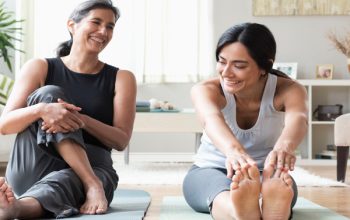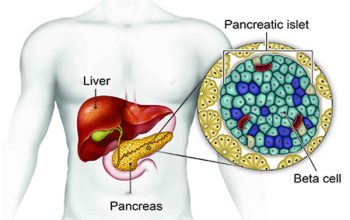Pain, when it haunts any part of the human body can be an unpleasant experience for the person enduring it. Be it momentary or chronic, one would always yearn to lead a healthy, happy life minus pain. Any kind of joint pain or pain to any part of the human body can cause discomfort not just to the person but it can always hamper one’s daily activities and general well being. In this topic, we will cover in detail how neck pain, in particular, is caused and how practicing yoga can effectively help to get rid of it.

What Causes Neck Pain
The main culprit leading to neck pain and related discomforts is oftentimes a bad posture built-up. It is a common issue seen mostly amongst grownups and is either related to lifestyle or one’s profession. When one adopts a poorly posture, over a period of time, it can cause straining of the neck muscles which in turn ends up in neck pain. When one speaks of poor posture it can also mean when one is asleep. Using an uncomfortable pillow can also lead to neck pain. Another cause of neck pain is chronic joint-conditions like osteoarthritis. Injuries and certain diseases like rheumatoid arthritis, meningitis, nerve compression, etc can also cause neck pain. You know you are suffering from a neck muscle-strain when you notice the following:
- Tightness around the neck muscles.
- Sudden spasms around the neck which may or may not last for a long period of time.
- Pain in the neck when you hold it in one position for long like whilst one is at their workplace peering into the computer screen.
- Unable to move neck freely.
- Neck stiffness.
- Headache
Minor neck pain and related discomfort can be treated at home. The person simply may need to straighten their posture and relax it out. Products like Neck Relax, which is a comfortable neck-brace, can be used to relieve the person from neck pain to an extend. It is easy to wear and won’t hinder daily activities. More often neck-strains won’t require any medical attention. It is when the condition persists and worsens that they may need to see a doctor or an expert.
Yoga To Combat Neck Pain
Yoga has prevailed on the surface of the earth for over 5000 years which is also one of the main reasons why one can turn to this simple yet powerful treatment method reliably. For years yogis have effectively treated people through yogic asanas ensuring not just ease of diseases and ailments but have also ensured the overall well being and healthy existence of its followers. When one speaks of neck pain, more popularly known as Cervicalgia in the medical world, it refers to the ailment experienced in one of the tenderest parts of the human body which supports our head and hence also makes it an important part that needs to be dealt with love and care.
Yoga Asanas to Relieve Neck Pain
Mentioned below are some simple yoga asanas which can be practiced at home to help ease one’s neck pain:
Bharadvaja’s Twist
- Sit down on the floor with legs outstretched. Gently shifting onto the right buttock, bend the knees and swing legs to the left. Rest the feet on, outside the left hip, touching the floor ensuring the left ankle rests in the right arch.
- Inhale and stretch to lengthen the front part of the body. Then exhale and twist the body to the right making sure the left buttock is either touching or close to the floor. Stretch the tailbone area for the lower back to be sufficiently stretched. Loosen muscles around the stomach.
- Place tightened the left hand under the right knee, placing the right hand beside the right buttock, on the floor. Pulling back the left shoulder gently, press the shoulder blades firmly against the back twisting the chest to the right.
- Continue twisting the torso turning it to the right, simultaneously turning the head to the right.
- Each time you inhale lift the breastbone slightly using the fingers n the floor to gently push-up and each time you exhale twist some more. Stay in the position for up to 1 minute, exhale slowly, and then return to the initial position. Repeat the same to the left.
Avoid this pose in case of menstruation, diarrhea, low or high blood pressure, headache, insomnia.
Marjariasana
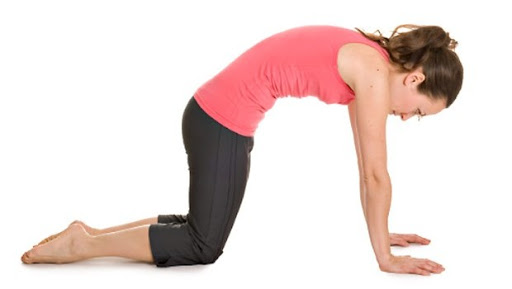
- Lower yourself onto the floor taking the shape of a table where the back becomes the table-top whilst the hands and feet become the legs of the table, coming onto all fours.
- Place the knees as wide as the hips.
- Inhale, raising the chin. Gently tilt the head back pushing the navel downwards and raise the tailbone.
- Inhale and exhale deeply and slowly.
- Exhale again, then drop the chin to the chest and turn the back into an arch shape stretching maximum.
- Hold the pose for a bit then return to the table-like position.
- Repeat the above 5-6 times, all the while taking long, deep breaths.
Avoid the pose if one has back problems.
Viparita Karani Asana
- Lie on the back with buttocks touching a wall, lifting the legs straight up against the wall.
- The feet should be parallel to the ceiling.
- Place both arms close to the body with palms facing the ceiling.
- Gradually bring the legs down bending the knees first taking long deep breaths. Turn to the left and gently bring the body to sitting position.
Avoid the pose in case of back pain or chronic neck-related issues
Savasana
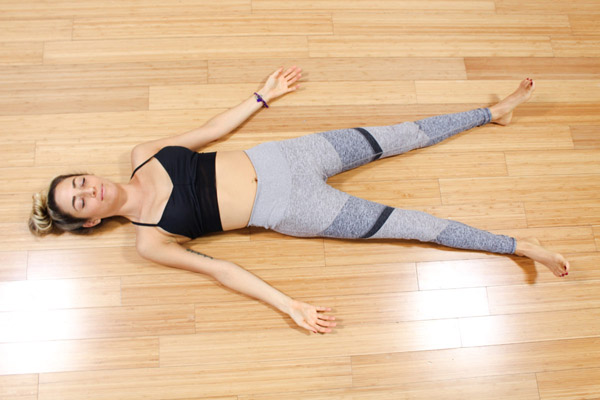
- Lie down on the floor on your back with eyes closed, legs comfortably apart allowing the feet and knees to completely relax.
- Place both arms along the length of the body with the palms facing upwards.
- Slowly and gently bring each body part to a complete relaxation mode beginning with the right foot, then slowly move to the right knee. Do the same with the other leg, then slowly go upwards to each body part one-by-one up until the head.
- Continue breathing gently and deeply, relaxing with each breath you take.
- After about 20 mins, roll onto the side keeping the eyes closed.
- Remain in that position for about a minute after which using the right hand gently sit up.
- Relax and take a few deep breaths and then gently open both eyes.
Utthita Trikonasana
- Stand upright and spread t both legs as wide as possible.
- Stretch out both hands sidewards keeping the back straight.
- Take a deep breath and slowly bend rightwards touching the right ankle with your right hand and left hand facing upwards.
- Look at the left hand whilst in this position.
- Breathe in and out gently allowing the body and mind to rest. Take some more breaths and gently lift the body and come back to standing position.
- Repeat the same to the left side of the body.
Avoid this asana if you have a heart condition, diarrhea, low blood pressure, headache.
Natarajasana
- Lie flat on the back with arms placed horizontally outstretched.
- Bending the knees brings feet near to the hips making sure the soles are fully on the floor.
- Swing knees to the left touching the left knee to the ground, turning the head to the right to stare at the right palm.
- Make sure the shoulder blades touch the ground. Exhale and relax with each exhalation, observing the spots where the body feels stretched.
- Repeat the steps on the other side after some minutes.
Avoid the asana in case of pregnancy.
Balasana
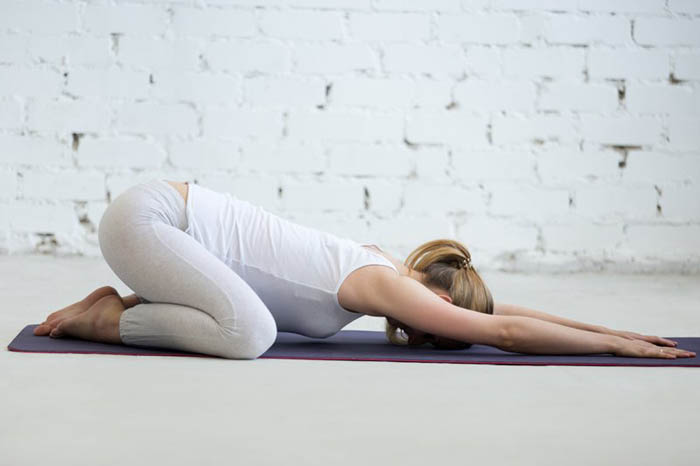
- Sit resting the hips on the heels. Bend forward lowering the forehead to the floor.
- Place both arms along the length of the body, hands touching the floor, palms facing up.
- Gently press down the chest upon the thighs and remain in the position for a few minutes.
- Slowly raise the body and sit back on the heels, uncurling the body and relaxing slowly.
Avoid the asana during pregnancy, if one has neck/back injury, in case of diarrhea.
Conclusion
The yoga poses mentioned in this article are not only easy to follow but can also be carried out in the convenience and comfort of one’s home. These asanas guarantee the best results with zero to no investments and are hardly time-consuming as well. Commitment and patience is the key which one needs to bear in mind while practicing yoga. After an initial discussion with one’s physician and under the supervision of a trained Yoga Instructor, following rules and conditions properly, one is good to venture on the road to recovery to lead a pain-free life.
